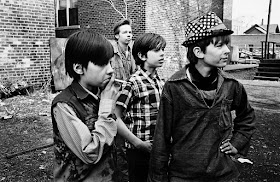The Republic of Gilead, in what used to be the Northeastern United States, is run on strictly Protestant fundamentalist principles. If the Bible says to stone adulterers to death, that's what we're going to do. Adulterers, fornicators, sodomites, Catholics, and Jews are all executed, unless they are fertile women who can become handmaidens, given the job of getting pregnant in the place of their owner's wife.
June (Elisabeth Moss) was a book editor before, but women are no longer permitted to have jobs, or even to read -- if they are caught reading, their hand gets chopped off. Because she was married to a divorced man, she is an adulterer, sentenced to become the handmaiden to Commander Fred Waterhouse and his wife, Serena Joy. Her name was changed to Offred (Of-Fred) to designate that she was his property.
Serena Joy is not altogether happy with the world she helped to create. She was once a conservative Christian activist who wrote books and held rallies on why women should stay home, and now she is cut off from all decision making ("we have men working on it").
Male infertility doesn't exist. If Offred doesn't get pregnant, she will be sent to the Colonies for a quick, painful death handling radioactive waste.
Although these are fundamentalists, they don't follow any of the rules I knew as a Nazarene. They smoke and drink. There is no religious music. There don't seem to be any church services. One gets the impression that they're Protestant fundamentalists without religion.

There are no gay male characters -- they've all been killed. There are several lesbian characters, including June's best friend from before, Moira (Samira Wiley), and Emily (Alexis Bleidel), married with a child before, now forced to become a handmaiden, first Ofglen, then Ofwarren. When she is found in a relationship with a Martha (a household servant), the Martha is executed, and she is "fixed" through genital mutilation.
Although there are parallels with today's facist society, there are significant differences. Racism doesn't exist in Gilead. There are black and Asian Commanders and wives. Nor is anyone screaming about illegal aliens. One assumes that the society is anti-Muslim as well as anti-Jewish and anti-Catholic, but this is never mentioned. The main injustice is that of women, "restored to their rightful place" in the household, with men in charge.
You don't watch The Handmaid's Tale for beefcake. It's about women's thoughts, women's lives, women's bodies. There are very few men around, except for soldiers with guns, and only three men in the main cast:
1. O.T. Fagbenle, who is gay in real life and a star of Looking, as Luke, Ofred's husband, who managed to escape and helps runs a resistance force called Mayday. He appears mostly in flashbacks.
2. Joseph Fiennes, who played a gay character in Running with Scissors, as the singularly unattractive Fred, who has a fetishistic interest in watching Offred do forbidden things like play Scrabble and read fashion magazines. He's always fully clothed, even in the scenes where he has to have sex with Offred.
3. Max Minghella, who played a gay character in The Mindy Project, as Nick, the Commander's chauffeur, also an Eye of God (informer) and possibly a member of the resistance. He begins an illicit romance with Offred. He's the only one to appear shirtless, and we even get a shot of his butt.
See also: The Handmaid's Tale, Season 2



















